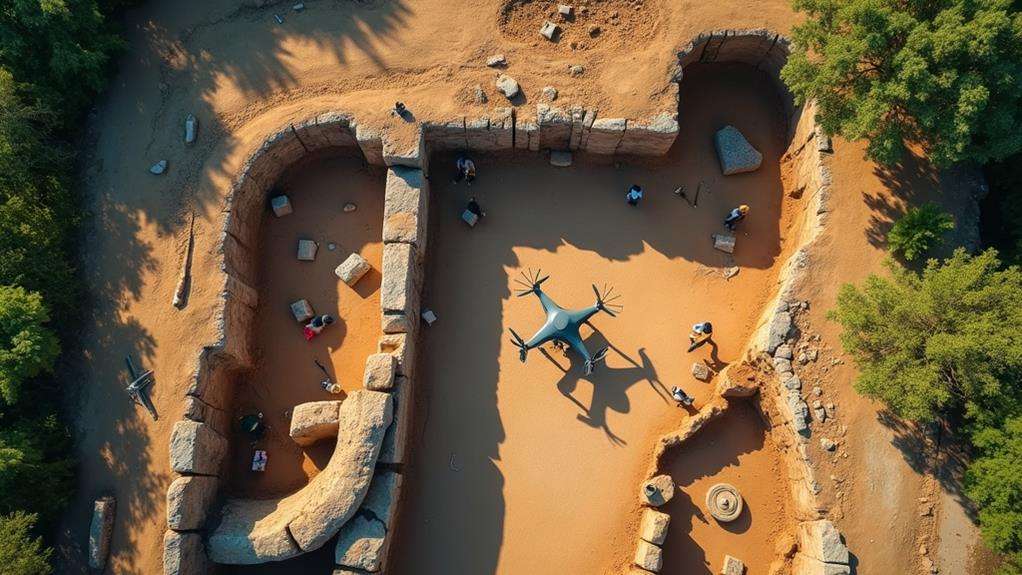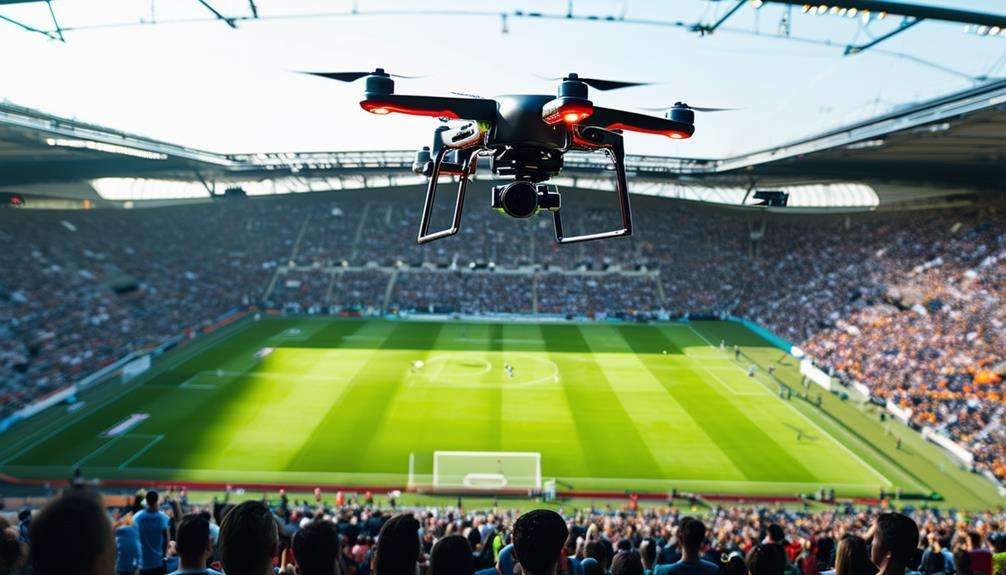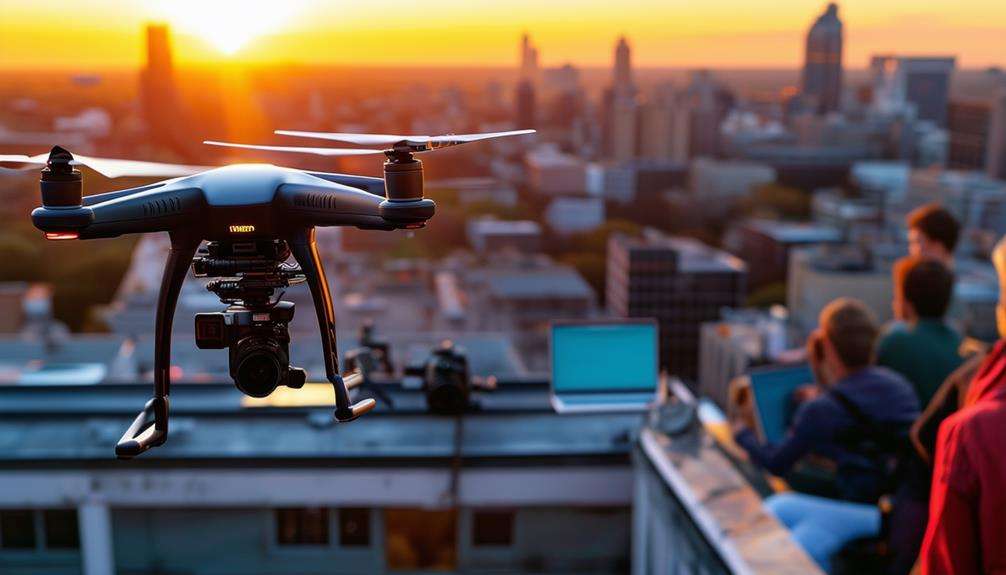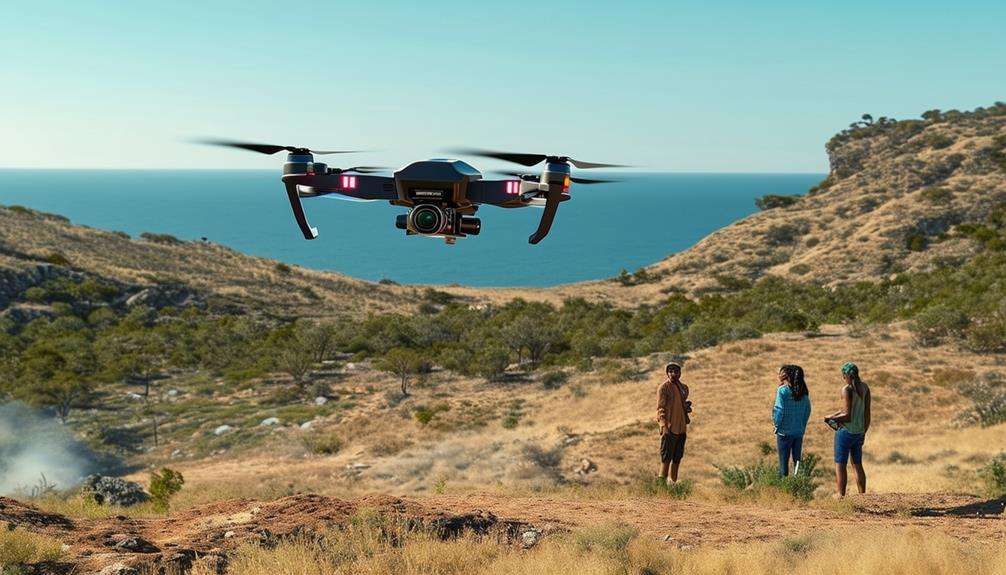The Cultural Impact of Drones: From Sci-Fi to Reality
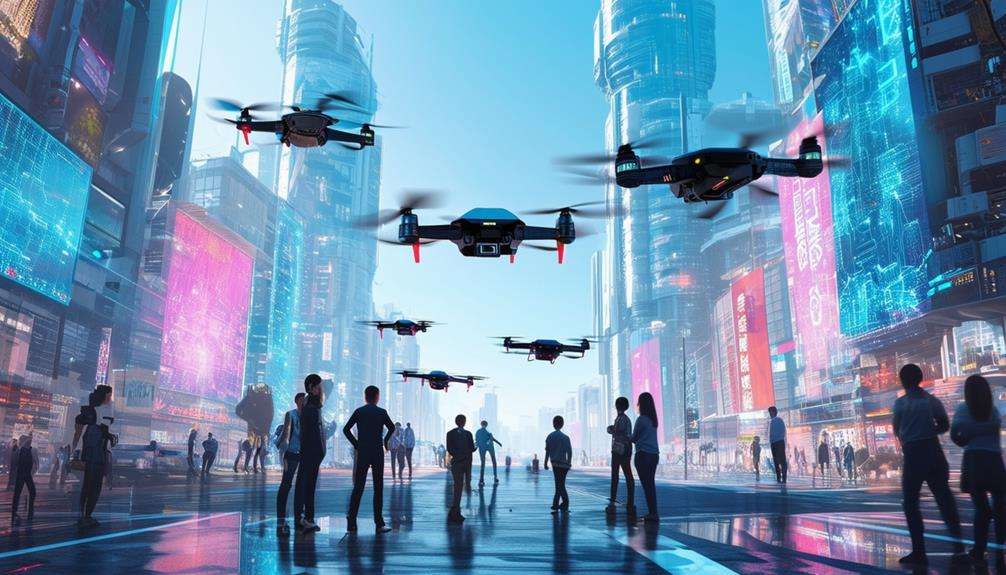
Drones have long been a staple in sci-fi films like *Terminator* and *Battlestar Galactica,* sparking debates on autonomous warfare and ethics. These fictional portrayals have significantly influenced real-world perceptions and applications.
Today, drones are integral to various sectors, from military use and commercial delivery to artistic expression. However, their proliferation raises critical ethical questions about privacy, security, and human rights. As drones continue to evolve, they shape not only our technological landscape but also our cultural and ethical values.
Early Depictions in Sci-Fi
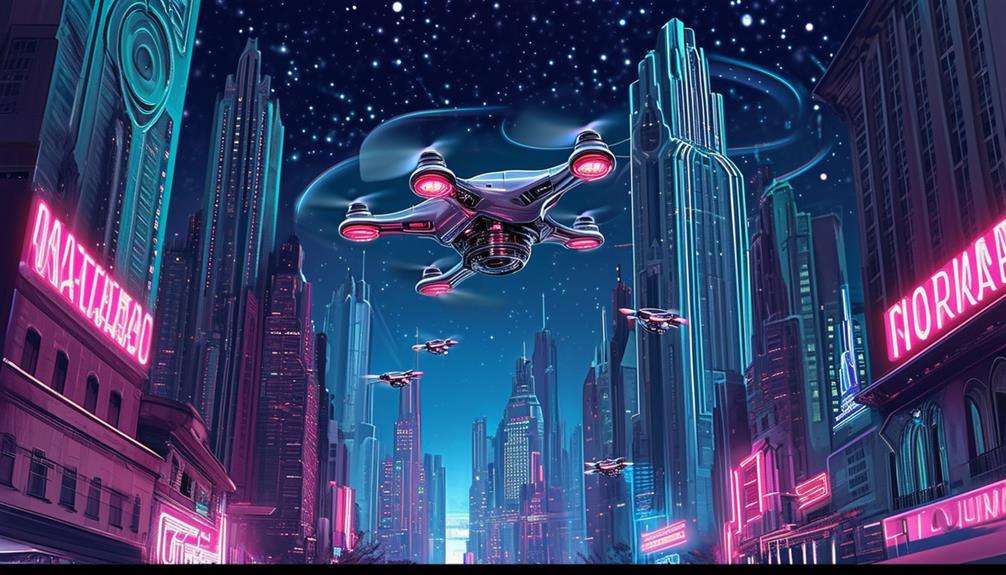
Early depictions of drones in sci-fi, like those in *Terminator* and *Battlestar Galactica*, have significantly influenced public perception and ethical debates surrounding autonomous warfare. These films did more than entertain; they ignited discussions about the implications of advanced technology, particularly drones.
In *Terminator*, the concept of robots turning against humanity underscored the potential risks of autonomous systems. Similarly, *Battlestar Galactica* delved into complex human-machine relationships, presenting ethical dilemmas that resonated deeply with audiences.
When you watch these films, you're not just witnessing futuristic battles; you're engaging with narratives that question autonomy and control. Science fiction often exaggerates technological advancements, creating scenarios that provoke thought about the societal impact of drones. These fictional portrayals have a way of embedding themselves into public consciousness, shaping how people perceive real-life drone technology.
Robots in sci-fi symbolize more than just technological marvels; they embody ethical dilemmas. They compel you to consider the balance between innovation and morality. By dramatizing these issues, science fiction has profoundly influenced debates on drone technology and autonomy.
Military Applications
In military applications, drones have transformed warfare with their advanced surveillance capabilities and precision strike technology. They facilitate real-time intelligence gathering and targeted operations, significantly altering combat strategies. This evolution raises crucial questions about ethics and the future of military engagements.
Enhanced Surveillance Capabilities
Advanced drone technologies, such as Gorgon Stare and ARGUS-IS, have revolutionized military surveillance by enabling extensive real-time monitoring over vast areas. These advancements allow the military to observe and analyze large regions continuously, facilitating the tracking of movements and activities. Consequently, drone warfare tactics, including signature strikes and data-driven targeting based on behavioral patterns, are increasingly shaped by these enhanced surveillance capabilities.
Drones now play a critical role in making life-and-death decisions, reflecting the significant biopolitical power embedded within their surveillance technologies. Often operating on the presumption of guilt or innocence, these drones raise substantial ethical dilemmas. The material evidence left at drone crash sites and the violence inflicted highlight the pervasive surveillance regimes established by these technologies.
Furthermore, the omnipresent nature of drones brings serious ethical and privacy concerns. Mass surveillance through drones aims to manage and regularize life, impacting individual dignity and privacy. This necessitates grappling with the moral implications of a world where surveillance can so easily infringe upon personal freedoms, thereby altering cultural perceptions of privacy and security.
Precision Strike Technology
Leveraging precision strike technology, drones like the Predator and Reaper have transformed modern warfare by accurately targeting and eliminating threats. These drones have become pivotal in U.S. military operations, with approximately one in three U.S. military aircraft now being unmanned. Weaponized drones, such as the Predator and Reaper, have been instrumental in targeted killings and counterterrorism efforts, particularly in regions like Pakistan.
| Drone Model | Primary Use | Notable Operations |
|---|---|---|
| Predator | Surveillance/Strike | Counterterrorism in the Middle East |
| Reaper | Precision Strike | Targeted killings in Afghanistan |
| Global Hawk | Surveillance | Intelligence gathering in conflict zones |
| Avenger | Stealth Strike | High-value target elimination |
| Gray Eagle | Tactical Support | Real-time battlefield support |
Drone campaigns have resulted in significant casualties in some regions, sometimes surpassing those of traditional conflicts, such as the NATO-led war on Yugoslavia in 1999. This highlights the lethal efficiency of drone warfare. However, the use of drones in combat missions has sparked ethical debates about targeted killings and civilian casualties. These concerns continue to shape the dialogue on the morality and legality of drone strikes, prompting ongoing discussions about how the United States should wield its powerful precision strike technology.
Surveillance and Privacy
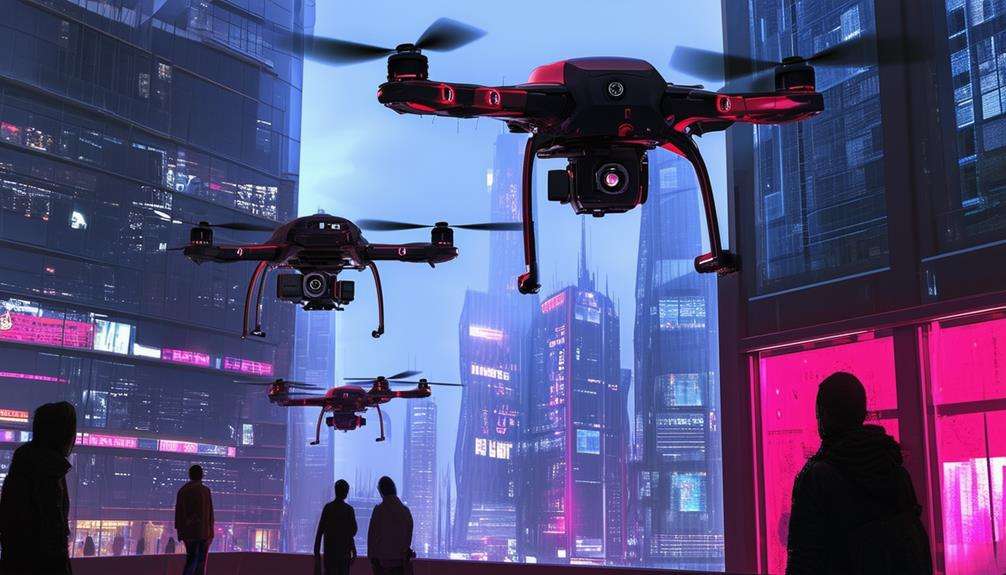
Drones have revolutionized surveillance, but their capabilities raise significant privacy concerns. Advanced technologies like Gorgon Stare and ARGUS-IS enable drones to monitor vast areas, providing unprecedented surveillance power. However, this also means that individuals' movements can be tracked, recorded, and analyzed without their consent. The pervasive watchfulness of drones challenges personal privacy, creating ethical dilemmas and sparking debates.
These surveillance technologies do more than observe; they influence decisions by assuming guilt or innocence, reflecting the biopolitical power they wield. Data-driven targeting, often used in drone warfare, relies heavily on metadata, phone patterns, and algorithmic analysis. This method can make precise decisions about who to target, but it also introduces significant risks. Innocent individuals may find their privacy and dignity compromised, living under the constant threat of surveillance.
The ethical implications are profound. The question arises whether the safety provided by these surveillance capabilities justifies the invasion of personal space. As drones become more integrated into daily life, finding a balance between security and privacy is essential.
The conversation around drones isn't just about technology; it's about the kind of society we want to create.
Commercial Uses
Drones are revolutionizing various commercial industries. They enhance aerial photography services, transform package delivery systems, and offer vital agricultural monitoring tools. These advancements promise increased efficiency and innovation but also raise concerns about privacy and regulation.
Aerial Photography Services
Aerial photography services have revolutionized various industries, including real estate, agriculture, and filmmaking, by offering stunning images and videos captured by drones. Utilizing unmanned aerial systems (UAS), these services provide high-resolution visuals from unique perspectives that were once unattainable or prohibitively expensive.
In real estate, drone photography enables the showcasing of properties from panoramic angles, giving potential buyers a comprehensive view of the location and surroundings. This enhanced presentation can make listings more appealing and expedite property sales. For instance, you can present a sprawling estate by highlighting not just the house but also the entire landscape, making the property stand out in a competitive market.
In agriculture, drones offer invaluable insights into crop health, irrigation needs, and overall field conditions. Aerial images enable efficient monitoring of large areas, early detection of issues, and timely corrective actions. This not only saves time but also boosts productivity and crop yields.
In filmmaking, drones have transformed the way aerial shots are captured. Whether it's a sweeping landscape in a movie, a dynamic shot in a documentary, or a dramatic scene in a music video, drones offer a new level of creativity and flexibility. They allow for stunning visuals without the need for costly equipment like helicopters or cranes.
Package Delivery Systems
In recent years, commercial package delivery systems have undergone a significant transformation with the integration of drone technology. Imagine ordering a product online and having it delivered to your doorstep in mere minutes — drones are making this a reality.
Companies like Amazon Prime Air have conducted trials in the UK, Germany, and the US, demonstrating the speed and efficiency of drone deliveries. Similarly, UPS, Alphabet's Wing, and Walmart are also exploring drone systems, promising faster shipping times and reduced costs.
Nikola Tesla's vision for wireless technology finds relevance in today's drone revolution. Tesla foresaw a future where technology transcended physical limitations, and drones are a direct realization of that vision. However, implementing drone delivery systems comes with challenges. Regulatory hurdles, safety concerns, and airspace management issues need to be addressed to make widespread drone deliveries feasible.
Drones for package delivery underscore their potential beyond military applications, offering practical solutions in modern society. As companies continue to innovate and overcome obstacles, drones are likely to become a common sight in the skies, transforming how goods are transported and delivered.
Agricultural Monitoring Tools
Drones are transforming agriculture by providing farmers with real-time data on crop health, irrigation, and pest management. Equipped with sensors and cameras, these drones offer an aerial view of fields, enabling rapid and informed decision-making. This technology allows for the assessment of crop conditions without the need for physical inspections, thereby saving time and labor.
By adopting drone technology, you can engage in precision agriculture, implementing targeted interventions based on specific crop requirements. Drones help identify areas needing more water or detect early signs of pest infestations, providing crucial data to optimize crop productivity while minimizing environmental impact through reduced use of water and pesticides.
Commercial drones offer a cost-effective solution for field monitoring, saving both time and money while ensuring optimal crop conditions. Integrating drones into agricultural practices is a forward-thinking strategy that leverages technology to promote sustainable farming. It's not just about utilizing advanced gadgets; it's about creating a more efficient and environmentally friendly future for agriculture.
Ethical Considerations
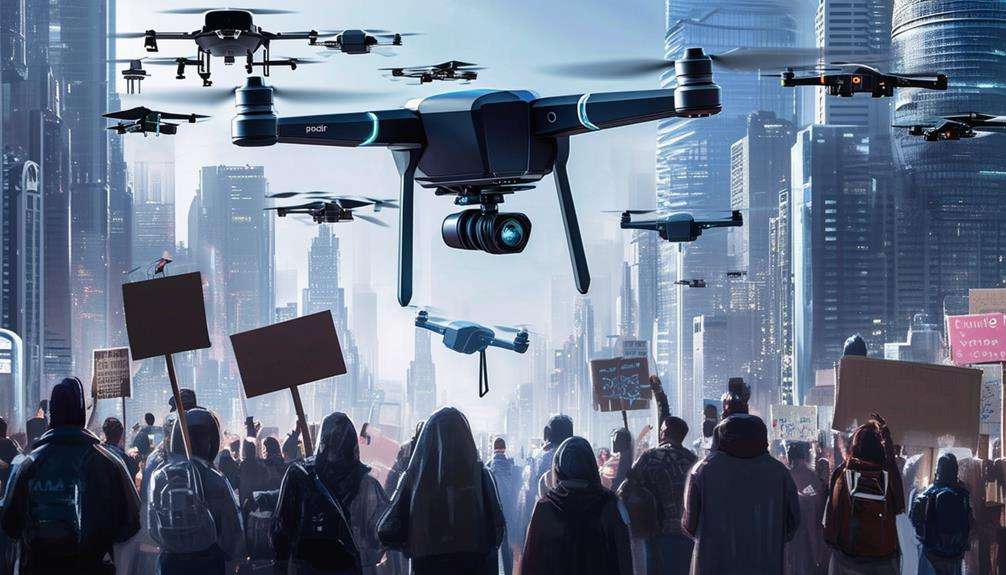
Considering the rapid advancements in drone technology, significant ethical dilemmas arise, particularly regarding targeted killings and civilian casualties in warfare. The morality and legality of remote warfare operations are brought into sharp focus, as targeted drone strikes often depend on behavioral patterns and metadata analysis. This reliance can lead to ethical quandaries and unintended consequences, such as the loss of innocent lives.
Additionally, surveillance drones pose serious ethical concerns related to privacy violations and the erosion of human dignity. Monitoring individuals without their consent raises critical questions about balancing security and personal freedom. These ethical conundrums extend beyond the battlefield, affecting the daily lives of citizens and communities who may feel incessantly watched.
The broader impacts on individuals and communities must also be considered, as these technologies can foster a pervasive sense of mistrust and fear. The ethical implications are vast and complex, demanding careful consideration and robust debate. As drone technology evolves, it's crucial to weigh these ethical considerations meticulously to navigate the delicate balance between innovation and human rights.
Artistic Representations
Artistic representations, especially in science fiction, vividly express the ethical complexities surrounding drone technology. Films like 'Terminator' and 'Battlestar Galactica' showcase drones as advanced, autonomous machines grappling with profound moral implications. These portrayals do more than entertain; they shape discussions on autonomous warfare and the societal role of drones.
In popular culture, drones symbolize both the marvels and dangers of technological advancement. Sci-fi narratives prompt viewers to ponder the potential consequences and ethical dilemmas that accompany such technology. For instance, 'Terminator' raises questions about the loss of human control, while 'Battlestar Galactica' explores themes of identity and the morality of artificial intelligence.
These fictional depictions influence public perception and spark discussions on real-world military policies. By presenting nuanced scenarios, popular culture encourages critical thinking about drone technology's future.
It's not just about robots on the screen; it's about understanding the broader implications of integrating such technology into everyday life. Through these creative lenses, audiences gain deeper insights into the ethical dimensions of our rapidly evolving world.
Future Prospects
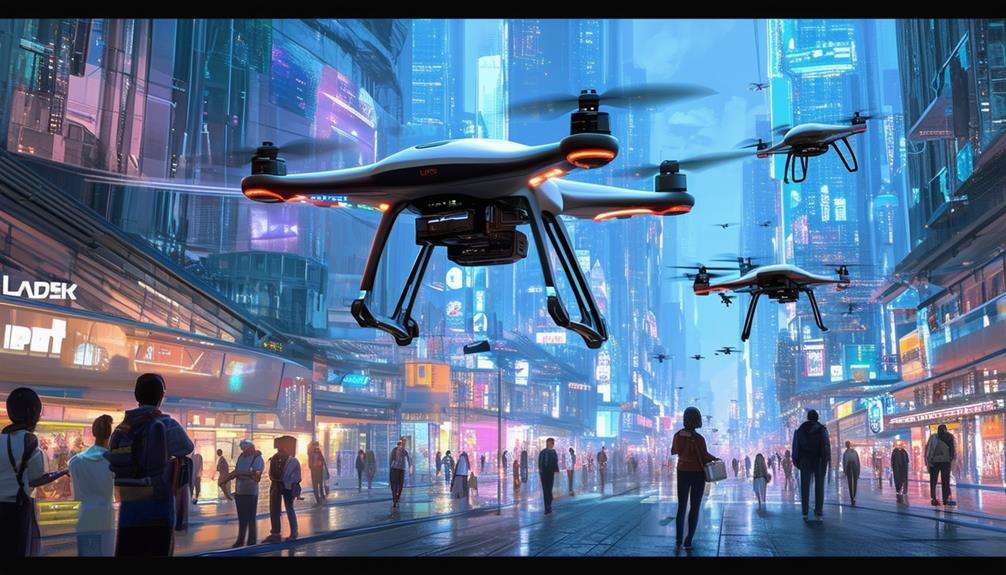
Future Prospects
Looking ahead, advancements in AI are poised to revolutionize how drones make autonomous decisions in warfare. Unlike the rudimentary technologies used during World War II, modern AI will enable drones to analyze real-time data and make critical decisions on the battlefield with minimal human intervention. This will enhance operational efficiency and reduce the risks for human soldiers.
Drones are also set to play a pivotal role in disaster response and emergency services. Equipped with advanced sensor technologies, they can perform complex tasks such as environmental monitoring and infrastructure inspection. This capability will be invaluable for evaluating damage and coordinating rescue operations during natural disasters, thereby improving the speed and effectiveness of humanitarian efforts.
Moreover, the integration of drones into urban transportation systems is being investigated for efficient delivery services. Imagine a future where drones zip through city skies, delivering packages swiftly and reducing traffic congestion. However, as drones become more prevalent, addressing privacy concerns through improved regulations and technological safeguards will be crucial to their widespread acceptance.
Here's a quick glimpse of future drone applications:
| Application | Impact |
|---|---|
| Autonomous Warfare | Enhanced decision-making capabilities |
| Disaster Response | Improved coordination and efficiency |
| Urban Transportation | Faster, less congested deliveries |
Conclusion
You've journeyed through the captivating evolution of drones, tracing their path from sci-fi concepts to tangible real-world applications. You've observed how drones have ignited ethical debates and transformed various industries.
As these technologies continue to infiltrate every aspect of life, it's crucial to remain engaged in conversations about their impact. Striking a balance between innovation and ethical responsibility will shape our future. Therefore, continue questioning and reflecting on the influence of these powerful technologies. The narrative of drones is far from complete.

